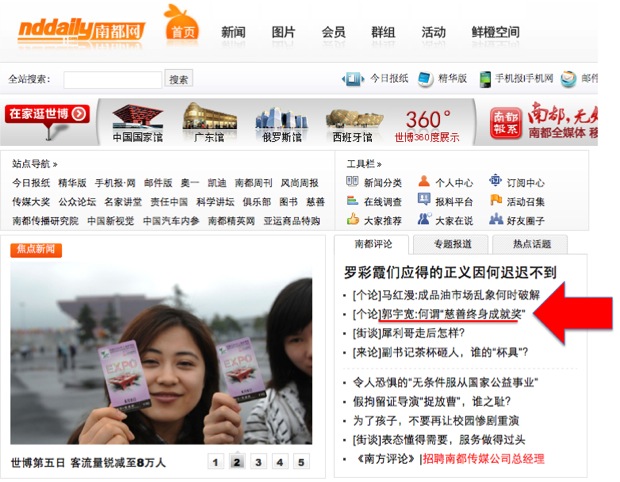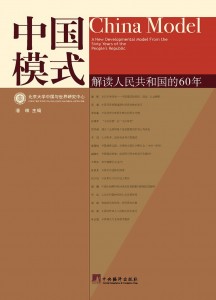In the following group of short essays, which I have called “On Democracy,” I’ll discuss the issue of democracy by responding to a number of questions my readers have raised, and then connecting these to the present-day situation in China. I will do my utmost to keep the essays under 2,000 words in order to convenience those youngsters who otherwise lack sufficient patience to read them through to the end. These essays are well suited to those under 30 years of age, and they might serve as useful accessories, or amusements, for university and secondary students as they engage in their habitual transmission of democratic concepts to those around them. ^_^
I’ll begin this essay with a letter from one of my readers.
In recent days, “Red Shirt” protesters in Thailand have taken to the streets opposing the government, paralyzing the country’s capital, and many readers have written to me about this. One long-time reader wrote to me and said painfully: “When I watch this Thai-style democracy, I feel pained. Perhaps it’s true that we lack the cultural capacity for democracy in Asia, that we have no democratic traditions? And perhaps we’ve taken this democracy that took root in Europe over two-thousand years and planted it on our own doorsteps, and that’s why problems arise. Could Teacher Yang offer some direction? . . . ”
I never found the time to write back to say that not only did the roots of democracy go back 2,000 years, but in fact they originated in Greece, the birthplace of Western democracy, where there have just recently been popular demonstrations to oppose the government.
I supposed the reader would get along fine without my “direction.” A couple of days later, though, he sent another letter, and this time his despondency was even more palpable: “Teacher Yang, it looks as though the democracy you hold so dear is not only unsuited to Asia, but look how problems have emerged even at democracy’s very source. Could it be that democracy has reached a dead end? Why is it that problems like this always occur in democratic countries? Is there any answer you can give? Thailand has left me really disappointed, and Greece has left me confused. Where does the hope lie?”
I had already decided by the time this letter came to write this series of short essays, so I didn’t give a personal response. What would I have said if I had? In light of the fact that he is a long-time reader, I might have harshly upbraided him: Kim Jong-Il has just made an official visit to China, so perhaps you could ask if any seats are available on his private train. If you could return with him to North Korea, perhaps you might get some sense of “hope.” If you stand in North Korea and gaze at the world from there, you will find that everything chaotic and inharmonious happens in democratic nations. Of course, compared to North Korea, just about every nation on earth could be called “democratic” . . . .
Over the past few years, I’ve received thousands of letters like this, if not closer to ten thousand. They never concern the major principles of democracy, nor do they address its deeper theoretical questions. Most are concerned with the surface and minutia of democracy.
Naturally, I can understand how for these young people who have just barely dipped their toes into the world, these ripples are enough to influence their views of the world. And considering that these young people have not had an opportunity to live in the democratic West, and don’t necessarily have the time to read too widely about such things, I think it’s necessary to devote at least a few words to explain some of these things in a bit more depth.
In the On Democracy series to come I’ll address a number of aspects of the democracy as everyone talks about them in everyday speech, and these can be seen as supplements to the larger essays I’ve written before. But there will certainly still be points of error and slip ups. So I hope younger readers will leave comments and points of view after my article, and raise any issues they hope to talk about further. I’m not in the habit of writing short essays like these, and there are sure to be many issues that cannot be explained clearly in them. But if you raise things in the comments or in letters, I’ll do my best to do “remedial work” in the essays that come after.
As everyone knows, any academic article must have a methodology, and while the articles in my On Democracy series are not academic, they too have a methodology. Simply put, it can be summed up in two idioms with which mainland Chinese are very familiar: “seeking the truth through facts,” and “one divides into two” (一分为二) [i.e., the idea that all things show internal contradiction].
As someone who lives at the same time and in roughly equal measure under democratic and undemocratic systems (I spend about half of each year in each) I want to do my best to describe accurately [what I have experienced] — the good is good, and the bad is bad. As for “one divides into two,” I know that many friends have a distaste for these “dialectics” that have afflicted the country for many years — but any problem will benefit by being approached from both the positive and negative sides. Still, in this series of essays I will raise my own viewpoints and come to conclusions that I find to be accurate. But I leave the final conclusion to my readers themselves. If everyone can come to their own conclusions, I will consider my goal to have been reached.
Goodness, I’ve already written 1,000 words! ^_^
So let me return to that reader’s letter. Thailand’s democracy is certainly far inferior to that of Europe and America, and Greece’s cannot be counted among the best in the West. In a democratic system, for the people to take to the streets, even smashing the doors of the government, is not a strength to be flaunted. At the same time, this type of thing is not proof of the drawbacks of democratic systems — and it is certainly not evidence that democracy has gone wrong.
Concerning the cases in Thailand and Greece, these are about other problems, whether social or economic, and democratic systems are merely throwing these into relief. We’ll discuss these in the chapters to come.
Democracy is not a decorative vase, nor is it a pretty woman on the dancing stage that you can lust over but cannot touch. For democratic countries, while “perfect democracy” may be an ultimate goal, “imperfect democracy” has already become a fact of everyday life, a means for the pursuit of social justice and and economic fairness. When people find that their portion of “bread” has decreased (as in Greece), or when they find that a special interest group governs their country (as in Thailand), they take to the streets and demonstrate against the government, voicing their opinions and anger according to rights guaranteed them by their constitutions. This is a part of democracy, whether you choose to see it as a strength or a weakness.
There is a phrase we often have at the ready that goes like this: the democratic system is hitherto the least bad system the world has come up with. Those who say this are of course supporters of democracy, and what they’re trying to say is that democracy is a good thing. But there are of course some subtle differences between these two statements. In this series of essays, I’ll opt in preference of the former, along the following two strains: 1) democracy is in fact a poor system, with many faults and shortcomings, but 2) when it is compared to other other (non-democratic) systems in the world, it is clearly the least bad.
It’s a simple matter to state this argument, but of course when it comes to “seeking the truth through facts” and the dialectics of “one divides into two,” the task is not a simple one. This is true for democratic systems, just as it is for non-democratic ones. When we declare that the superior advantage of a system with Chinese characteristics (中国特色的制度) lies in its “concentration of resources to accomplish big tasks” (集中力量办大事”), we should admit to ourselves that there is some merit in this argument — otherwise, how could a nation in which more than 100 million people still live in poverty be able to manage the largest-scale Olympic Games and the largest-scale World Expo in history?
If we want to show off our overall level of national prosperity to the world, we’ll have to wait at least 50 years before we can feel proud and elated. But when this “concentration of resources to accomplish big tasks” can make ordinary Chinese, including the old granny selling duck eggs and the young woman washing your feet, feel a sense of national glory and honor, who can possibly argue that this is not an incomparable advantage? Still, even as we admit this advantage, we must recognize that over the last century the great things this system of “concentration of resources to accomplish big tasks” has accomplished have principally been “great evils,” most notably Stalin’s great purge and China’s Cultural Revolution.
And there is another way of looking at things. When the people so easily resort to the constitution and democracy as shields with which to take to the streets, this naturally causes people to think this way is not very harmonious. Some might even say this way is “very bad” (influencing traffic, upsetting the country’s international image and the lives and routines of ordinary people). But what are the methods like in nondemocratic systems? If people living in such places discover, as the Greeks have, that their real wages and benefits are going down, or if, as in Thailand, they are unhappy with the special interests governing their country, what will they do?
I think most of you realize that appealing to higher authorities and petitioning for redress (上访) are not very useful. If you’re willing, of course, self-immolation might draw some sort of response. The idea of thousands kneeling before the government offices [to seek redress] is something we are seeing anew, but of course it has proven an effective method for thousands of years [in China].
This is a question we must explore step by step in coming installments of On Democracy, until everyone can arrive at their own conclusions.
This essay originally appeared in Chinese at Yang Hengjun’s blog.




